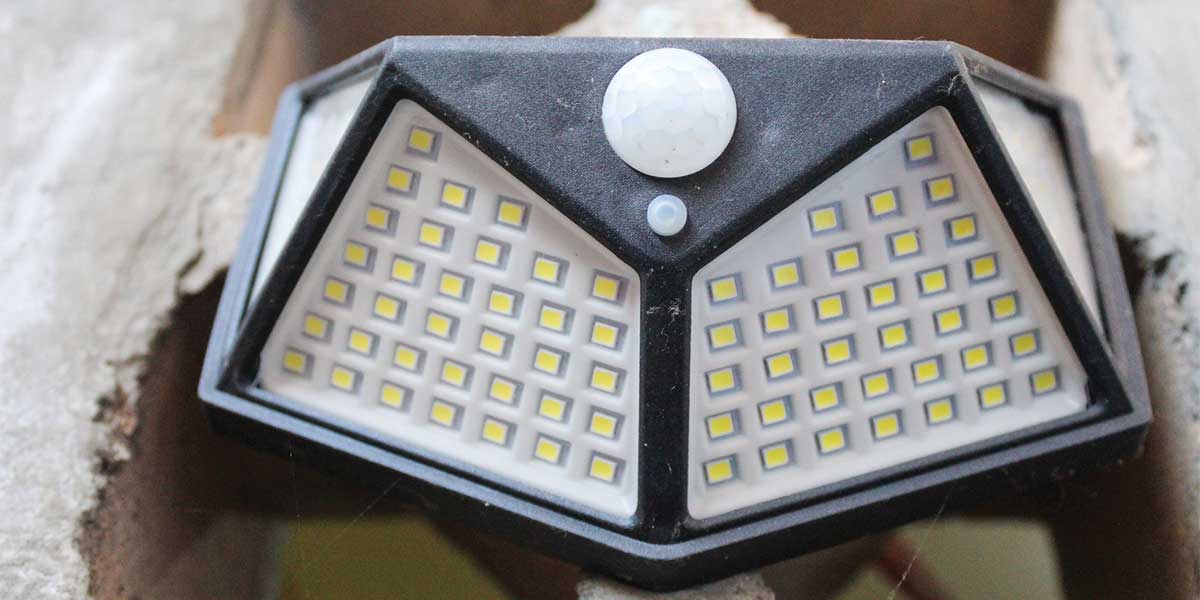The licensed electricians at Expert Electric receive many questions about how motion-sensing lights work and where to install them. Since our team has plenty of experience installing motion-sensing lights in residential homes and commercial buildings, it would be beneficial to help answer some of the more popular questions we receive. Keep reading to learn more about how motion-sensing lights work, where to install them, and how to do so.
How do motion-sensing lights work?
Many of us are familiar with motion-sensing lights, which have existed for some time. They frequently appear in spy films and may even be installed at your workplace. Motion-sensing lights are becoming an increasingly popular security measure in commercial business buildings and residential homes. These lights work by detecting infrared heat waves found on moving objects. To ensure that non-human objects do not trigger the sensors, it is necessary to dial them to a specific sensitivity setting that usually falls between 8 and 12 micrometers. Contacting a licensed electrician to ensure that sensing lights are installed and working correctly is best.
Where to install motion-sensing lights?
For residential homes, it is essential to install motion-sensing lights in different areas around the outside of the house, in both the front and back yard. For the front yard, consider installing motion-sensing lights to cover walkways, driveways, entranceways, and stairs. The backyard must cover areas like patios, hot tubs, swimming pools, and gates. Don’t feel that you should limit yourself to these areas.
The placement of motion-sensing lights is based on each home. A good rule of thumb is to cover the most common pathways to home entrances and dark and hazardous areas throughout the property. The same goes for commercial properties, although they will likely require a larger scale of motion-sensing lights due to their size and valuables. For questions about where to install motion-sensing lights on residential or commercial properties, contact the expert electricians at Expert Electric.

How to install motion sensing lights?
For commercial buildings and businesses, it is recommended that a licensed electrician takes care of the installation of motion-sensing lights. This will ensure the lights correctly protect the building and its valuables. Nowadays, installing motion-sensing lights in residential homes can be a simple process; however, dialing in the as well as the sensitive, ty settings so t, that the lights are not being prompted by non-human movement every hour of the night can be tricky. ,,,, A licensed electrician at Expert Electric can get your residential motion-sensing lights up and running in no time, allowing you to sleep safely and peacefully, free of frustrating false alarms.
Elevate your electrical system with Expert Electric’s unparalleled service. Whether you’re looking to enhance your indoor ambiance or brighten your outdoor spaces, our team at Expert Electric is your ultimate solution. Refrain from letting subpar electrical work dim your property’s potential. Choose experts ready to illuminate every corner with precision and care.
Dial 604-681-8338 today and embark on a journey to electrical excellence. With Expert Electric, you’re not just getting a service but investing in peace of mind, safety, and the sheer joy of flawless functionality. Our seasoned professionals are eager to tackle any challenge, big or small, ensuring your space is safe and shines with its full potential.
From the intricate wiring of your cozy indoor retreat to the vibrant energy of your outdoor oasis, Expert Electric is your reliable partner, dedicated to transforming your electrical dreams into reality. Our commitment to quality, safety, and customer satisfaction sets us apart, making us the go-to choice for discerning homeowners and businesses.
Don’t wait for a flicker to become a failure. Take the proactive step towards exceptional electrical health by calling Expert Electric at 604-681-8338. Let us empower your space with top-tier electrical work’s strength, beauty, and reliability. Join the many satisfied customers who trust Expert Electric to illuminate their lives. Call now and illuminate the path to electrical perfection. Your journey to a brighter, safer, and more efficient space begins with Expert Electric – where excellence is just a call away.


